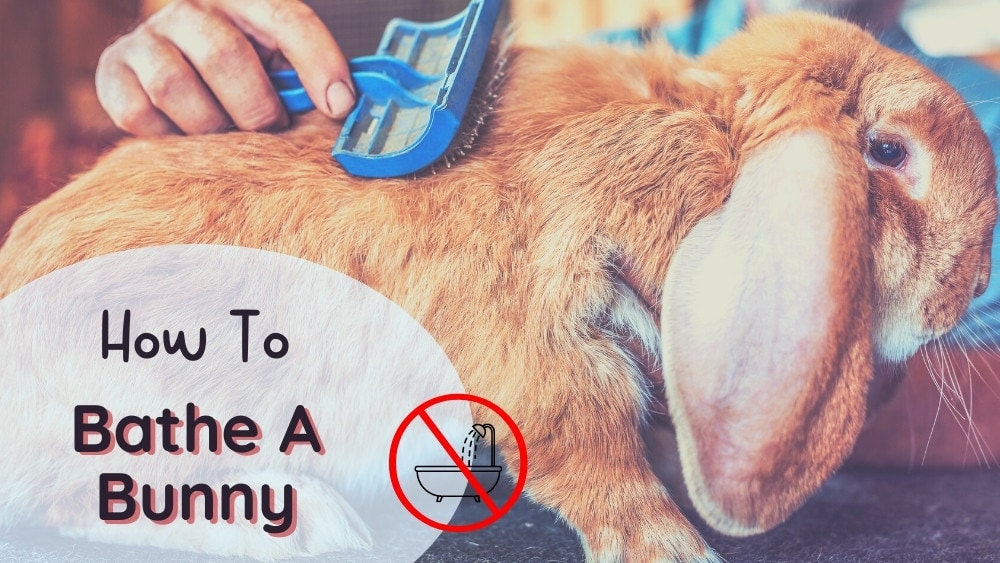Rabbits hate being dirty. In normal circumstances, rabbits keep themselves well-groomed with their little wash cloth tongues. But what should you do if your rabbit’s fur gets really filthy?
Maybe your rabbit had a ball playing in the garden, but came in with mud on his feet. Or maybe you rescued a poor long-haired rabbit, with droppings and shavings matted into its wool.
Maybe you have an older bunny with urine incontinence who needs a little help staying clean.
In each of these situations, your rabbit might need a bath – or at least a spot cleaning.
This tutorial will help you understand when and how to give your rabbit a bath.
How to Bathe a Bunny
You should never routinely bathe rabbits or submerge a bunny in water. However, there are safe ways to clean a pet rabbit. You can give your rabbit’s fur a dry bath with cornstarch to remove stains. You can also use a basin of warm water and an oil-based shampoo to wash his tail or feet.
Do Rabbits Need Baths?
Some species of pet animals need routine baths to stay healthy. Many people assume this principle applies to pet rabbits as well – and the results can be disastrous.
Full soap-and-water baths are actually dangerous for rabbits. I once attended a county fair show that required all the exhibitors to wash their rabbits before bringing them. (They had this rule for other species and applied it to rabbits without understanding the consequences.)
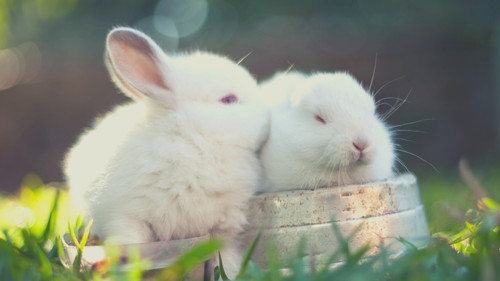
It was a terrible sight. I saw sad, shivering bunnies everywhere. Rabbit fur is supposed to lay flat along the body, forming a protective glossy coat. But washing these rabbits had stripped their coats of natural oils, leaving dry, disheveled fur sticking up in all the wrong directions.
So, no. Rabbits don’t need baths unless their fur is very dirty.
Risks of Giving Your Rabbit a Bath
Giving your rabbit a full bath, whether in the sink, tub, or with a hose, carries several serious risks. Risks of getting a rabbit wet to the skin include:
- Hypothermia
- Shock (can be fatal)
- Skin irritation
- Damaged fur structure (loss of insulation)
- Broken bones (if a rabbit struggles or jumps out of the sink)
- Stress (puts rabbit at risk of snuffles or other diseases)
Rabbits Groom Themselves and Each Other
As I’ve mentioned, rabbits are great at keeping themselves clean. They lick their fur multiple times a day to keep it in place and stimulate the production of healthy skin oils. Bonded rabbits that live in the same space will groom each other as well.
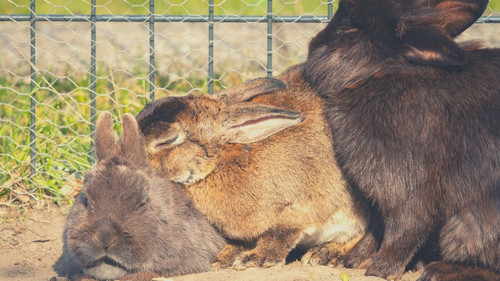
If you keep your rabbit in an appropriate enclosure, teach your rabbit to use a litter box, and clean its environment regularly, it’s unlikely your rabbit will need a bath.
But if he needs some help staying clean, apply these tips for how to bathe your rabbit safely.
How to Give a Rabbit a Dry Bath
This method of spot-cleaning rabbits works great for bunnies with urine stains on their fur.
Supplies you will need to spot-clean a rabbit:
- Rubbing Alcohol (70% Isopropyl Alcohol)
- Toothbrush
- Comb
- Cornstarch or Baby Powder
- Towel
- Brush Alcohol on to Stained Fur
Place your rabbit on a secure surface, such as a towel on the floor. Using a toothbrush, apply 70% rubbing alcohol on to stained or dirty fur.
Work the alcohol into the individual hairs with the toothbrush. You can also use warm water and a heavily-diluted hydrogen peroxide solution. The goal is to loosen the stain but get as little of the coat wet as possible.
- Sprinkle with Cornstarch
Sprinkle cornstarch or baby powder on to the wet fur to absorb the stain. Cornstarch will clump quickly, so keep it dry until it touches the wet fur.
- Comb it Through the Coat
As it dries, comb the cornstarch out of the fur with a medium-toothed comb.
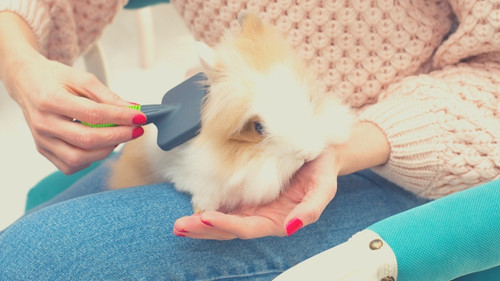
Try to remove as much as possible, so the rabbit won’t ingest it. You can use a dry towel to help rub it out of the coat.
- Clean Your Rabbit’s Ears
Use a cotton swab or q-tip with warm water to gently rub the upper portions of a rabbit’s ears. Do not stick the q-tip down into the lower parts of the ear! Avoid dripping water down into the ear as well.
Tip: It’s normal to see a little flaking skin or wax buildup on the interior of the ears. However, dark wax or crusty flaking skin is a sign of ear canker caused by ear mites.
- Clean Scent Glands
If your rabbit has a musky odor and you’re wondering how to get rid of your rabbit’s smell, you might need to clean your rabbit’s scent glands.
A bunny has scent glands under its chin and on either side of its rectum. The gland under the chin doesn’t need regular cleaning. But the ones on your bunny’s rear can harbor built-up oil, dead skin, and debris.
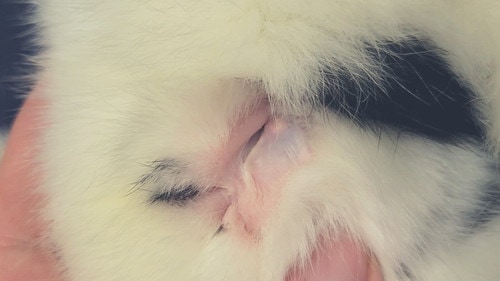
To clean a rabbit’s scent glands, sit on the floor and cradle your rabbit so you can see its genitals.
With your fingers, separate the fur on either side of your bunny’s private parts until you see slits in the skin. Wipe these areas with a cotton swab or cotton round dipped in warm water.
The video below gives a really helpful visual so you can locate the scent glands on your rabbit.
How to Give a Rabbit a Bum Bath
Sometimes rabbits need more extensive cleaning, usually on their hind parts.
If your rabbit likes to sit in his litter box or has a medical condition and cannot groom himself or consume cecotropes, you may need to wash your bunny’s bum.
Warning: If your rabbit has diarrhea, this is a sign of severe illness and you should call a veterinarian.
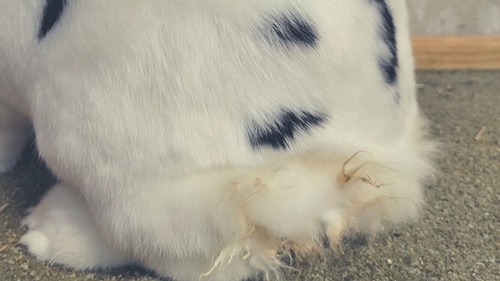
Supplies You Will Need to Wash a Rabbit’s Bum or Feet
- Dematting Comb
- Trimmers or small scissors
- Rabbit-safe Shampoo (optional)
- Two towels
- Basin or baby bathtub
- Hair dryer
- Warm water
What Soap is Safe for Rabbits?
Don’t use human shampoo on your bunny. If warm water isn’t strong enough to break up the debris stuck to your rabbit’s fur, you can use a pet-safe shampoo or castile soap in your rabbit’s bath.
Look for an unscented, oil-based shampoo with a short list of natural ingredients. I use Fluppets Certified Organic Pet Shampoo for my bunny.
Rabbit Butt Bath Step-by-Step Instructions
- Trim Fur and Remove Debris
If your rabbit has droppings or litter stuck to its fur, remove them as best as you can with your fingers.
You can use a small trimmer or dematting comb, but be extremely careful! Rabbits have very delicate skin that will tear with rough handling.
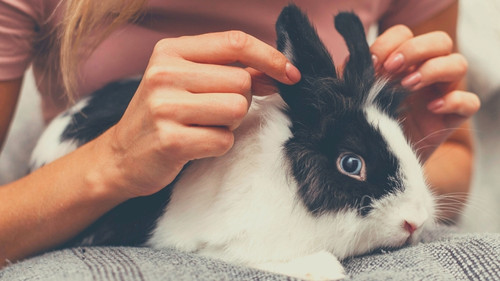
If you have a long-haired breed like a Jersey Wooly or Angora, you should trim the fur to 1” in length to prevent matting.
- Prepare the Bath
Use a small plastic bin or a baby bathtub to give your rabbit a bath. Line the bottom of the bin with a rubber mat or a towel to give it a non-slip surface.
Fill the tub with warm water – not hot or cold!
Rabbits’ average body temperature is 101-103°F. They can be easily burned by hot water or shocked by cold water.
Warning: Always bathe your rabbit in a basin on the floor or bathtub, not in a raised sink!
Your rabbit may be frightened during the bath and will probably try to get away. If a rabbit jumps out of your sink and lands on a tile floor, it could break its back.
- Bathe the Rabbit’s Butt
Holding the rabbit securely, place his back end into the water. Be prepared for your rabbit to jump or struggle.
Hold his upper parts against your chest until he relaxes. Keep a towel handy in case you need to remove the rabbit and give him a break.
Still holding your rabbit, gently massage the dirty areas with your fingers. Let the warm water soak into the debris. Use a small amount of shampoo if you need to.
- Rinse and Repeat
For severe cases of poopy butt, you may need to repeat this process. After soaking the rabbit, you can set him back on a towel and use the dematting tool to further break up the clumps of poop.
Place the bunny back into fresh bath water to rinse.
- Drying a Rabbit
Dry your rabbit with a towel, squeezing (not rubbing) his fur in the towel to remove moisture.
You can try to use a hair dryer on a warm, low-fan setting to dry your rabbit, but this could frighten him even more.
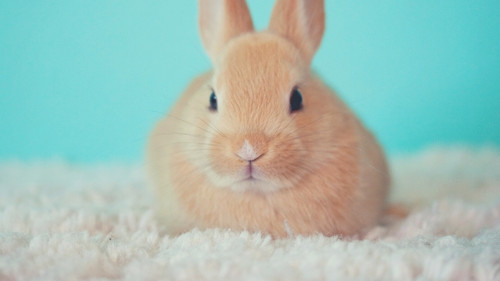
If your rabbit lives outdoors, you must keep him in the warm house until he’s 100% dry.
In the summer, wet rabbit fur can invite fly strike. In the colder months, placing a wet rabbit outside can cause his body temperature to drop dangerously low.
Should You Give a Rabbit a Shower?
If your rabbit’s fur gets dirty, try to clean it using a dry bath or a butt bath, rather than a shower.
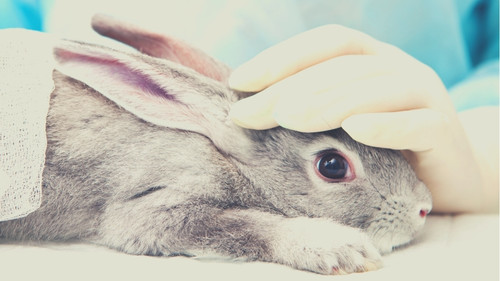
Avoid using running water on your rabbit from a shower, a sink tap, or a hose. Running water can wet your rabbit to the skin, increasing risk of hypothermia.
Should You Give a Rabbit a Flea Bath?
If you’re concerned that your rabbit has fleas, you should use a fine-toothed comb to remove any visible fleas and eggs.
Most flea powders and flea baths are not safe for rabbits. Please read our article on rabbit flea treatment to learn how to safely address a flea problem.
Conclusion
Even though rabbits are careful self-groomers, they need your help to stay clean. If you change your rabbit’s litter daily, provide it with a high-fiber diet, and act on any sign of illness right away, your bunny probably won’t need regular baths.
If your bunny does need spot cleaning or an occasional butt bath, I hope this tutorial helped answered your questions about how to bathe a rabbit in a safe way.


